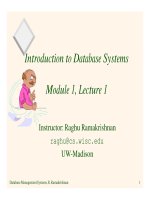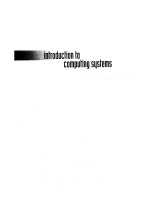Lecture Introduction to computing systems (2/e): Chapter 12 - Yale N. Patt, Sanjay J. Patel
Bạn đang xem bản rút gọn của tài liệu. Xem và tải ngay bản đầy đủ của tài liệu tại đây (391.21 KB, 32 trang )
Chapter 12
Variables and
Operators
Copyright © The McGraw-Hill Companies, Inc. Permission required for reproduction or display.
Basic C Elements
Variables
• named, typed data items
Operators
• predefined actions performed on data items
• combined with variables to form expressions, statements
Rules and usage
Implementation using LC-2
122
Copyright © The McGraw-Hill Companies, Inc. Permission required for reproduction or display.
Data Types
C has three basic data types
int
double
char
integer (at least 16 bits)
floating point (at least 32 bits)
character (at least 8 bits)
Exact size can vary, depending on processor
• int is supposed to be "natural" integer size;
for LC-2, that's 16 bits -- 32 bits for most modern processors
123
Copyright © The McGraw-Hill Companies, Inc. Permission required for reproduction or display.
Variable Names
Any combination of letters, numbers, and underscore (_)
Case matters
• "sum" is different than "Sum"
Cannot begin with a number
• usually, variables beginning with underscore
are used only in special library routines
Only first 31 characters are used
124
Copyright © The McGraw-Hill Companies, Inc. Permission required for reproduction or display.
Examples
Legal
i
wordsPerSecond
same identifier
words_per_second
_green
aReally_longName_moreThan31chars
aReally_longName_moreThan31characters
Illegal
10sdigit
ten'sdigit
done?
double
reserved keyword
125
Copyright © The McGraw-Hill Companies, Inc. Permission required for reproduction or display.
Literals
Integer
123
/*
-123
0x123 /*
Floating point
6.023
6.023e23
5E12
Character
'c'
'\n' /*
'\xA' /*
decimal */
hexadecimal */
/* 6.023 x 1023 */
/* 5.0 x 1012 */
newline */
ASCII 10 (0xA) */
126
Copyright © The McGraw-Hill Companies, Inc. Permission required for reproduction or display.
Scope: Global and Local
Where is the variable accessible?
Global: accessed anywhere in program
Local: only accessible in a particular region
Compiler infers scope from where variable is declared
• programmer doesn't have to explicitly state
Variable is local to the block in which it is declared
• block defined by open and closed braces { }
• can access variable declared in any "containing" block
Global variable is declared outside all blocks
127
Copyright © The McGraw-Hill Companies, Inc. Permission required for reproduction or display.
Example
#include <stdio.h>
int itsGlobal = 0;
main()
{
int itsLocal = 1;
/* local to main */
printf("Global %d Local %d\n", itsGlobal, itsLocal);
{
int itsLocal = 2;
/* local to this block */
itsGlobal = 4;
/* change global variable */
printf("Global %d Local %d\n", itsGlobal, itsLocal);
}
printf("Global %d Local %d\n", itsGlobal, itsLocal);
}
Output
Global 0 Local 1
Global 4 Local 2
Global 4 Local 1
128
Copyright © The McGraw-Hill Companies, Inc. Permission required for reproduction or display.
Symbol Table
Like assembler, compiler needs to know information
associated with identifiers
• in assembler, all identifiers were labels
and information is address
Compiler keeps more information
Name (identifier)
Name
Type
counter
startPoint
Location in memory
itsGlobal
Scope
Type
Offset
Scope
int
int
int
3
4
0
main
main
global
129
Copyright © The McGraw-Hill Companies, Inc. Permission required for reproduction or display.
Allocating Space for Variables
Global data section
0x0000
• All global variables stored here
(actually all static variables)
• R5 points to beginning
Run-time stack
• Used for local variables
• R6 points to storage area at
top of stack
• New storage area for each block
(goes away when block exited)
Offset = distance from beginning
of storage area
0xFFFF
• Global: LDR R1, R5, #4
• Local: LDR R2, R6, #6
instructions
global data
PC
R5
stack
R6
1210
Copyright © The McGraw-Hill Companies, Inc. Permission required for reproduction or display.
Variables and Memory Locations
In our examples,
a variable is always stored in memory.
When assigning to a variable,
must store to memory location.
A real compiler would perform code optimizations
that try to keep variables allocated in registers.
Why?
1211
Copyright © The McGraw-Hill Companies, Inc. Permission required for reproduction or display.
Operators
Programmers manipulate variables
using the operators provided by the high-level language.
Variables and operators combine to form
expressions and statements
which denote the work to be done by the program.
Each operator may correspond to many
machine instructions.
• Example: The multiply operator (*) typically requires
multiple LC-2 ADD instructions.
1212
Copyright © The McGraw-Hill Companies, Inc. Permission required for reproduction or display.
Expression
Any combination of variables, constants, operators,
and function calls
• every expression has a type,
derived from the types of its components
(according to C typing rules)
Examples:
counter >= STOP
x + sqrt(y)
x & z + 3 || 9 - w-- % 6
1213
Copyright © The McGraw-Hill Companies, Inc. Permission required for reproduction or display.
Statement
Expresses a complete unit of work
• executed in sequential order
Simple statement ends with semicolon
z = x * y; /* assign product to z */
y = y + 1; /* after multiplication */
; /* null statement */
Compound statement groups simple statements
using braces.
• syntactically equivalent to a simple statement
{
z = x * y; y = y + 1; }
1214
Copyright © The McGraw-Hill Companies, Inc. Permission required for reproduction or display.
Operators
Three things to know about each operator
(1) Function
• what does it do?
(2) Precedence
• in which order are operators combined?
• Example:
"a * b + c * d" is the same as "(a * b) + (c * d)"
because multiply (*) has a higher precedence than addition (+)
(3) Associativity
• in which order are operators of the same precedence
combined?
• Example:
"a - b - c" is the same as "(a - b) - c"
because add/sub associate left-to-right
1215
Copyright © The McGraw-Hill Companies, Inc. Permission required for reproduction or display.
Assignment Operator
Changes the value of a variable.
x = x + 4;
1. Evaluate righthand side.
2. Set lefthand side to result.
Corresponding LC-2 code:
LDR R2, R6, #3 ; load x
ADD R2, R2, #4 ; compute x+4
STR R2, R6, #3 ; store result to x
1216
Copyright © The McGraw-Hill Companies, Inc. Permission required for reproduction or display.
Assignment Operator
All expressions evaluate to a value,
even ones with the assignment operator.
For assignment, the result is the value assigned.
• usually (but not always) the value of the right-hand side
type conversion might make assigned value
different than computed value
Assignment associates right to left.
y = x = 3;
y gets the value 3, because (x = 3) evaluates to the value 3.
1217
Copyright © The McGraw-Hill Companies, Inc. Permission required for reproduction or display.
Arithmetic Operators
Symbol
*
/
%
+
-
Operation
multiply
divide
modulo
addition
subtraction
Usage
x * y
x / y
x % y
x + y
x - y
Precedence
Assoc
6
l-to-r
6
l-to-r
6
l-to-r
7
l-to-r
7
l-to-r
All associate left to right.
* / % have higher precedence than + -.
1218
Copyright © The McGraw-Hill Companies, Inc. Permission required for reproduction or display.
Arithmetic Expressions
If mixed types, smaller type is "promoted" to larger.
x + 4.3
if x is int, converted to double and result is double
Integer division -- fraction is dropped.
x / 3
if x is int and x=5, result is 1 (not 1.666666...)
Modulo -- result is remainder.
x % 3
if x is int and x=5, result is 2.
1219
Copyright © The McGraw-Hill Companies, Inc. Permission required for reproduction or display.
Practice with Precedence
Assume a=1, b=2, c=3, d=4.
x = a * b + c * d / 2; /* x = 8 */
same as:
x = (a * b) + ((c * d) / 2);
For long or confusing expressions,
use parentheses, because reader might not have
memorized precedence table.
Note: Assignment operator has lowest precedence,
so all the arithmetic operations on the right-hand side
are evaluated first.
1220
Copyright © The McGraw-Hill Companies, Inc. Permission required for reproduction or display.
Bitwise Operators
Symbol
~
<<
>>
&
^
|
Operation
bitwise NOT
left shift
right shift
bitwise AND
bitwise XOR
bitwise OR
Usage
~x
x << y
x >> y
x & y
x ^ y
x | y
Precedence
Assoc
4
r-to-l
8
l-to-r
8
l-to-r
11
l-to-r
12
l-to-r
13
l-to-r
Operate on variables bit-by-bit.
• Like LC-2 AND and NOT instructions.
Shift operations are logical (not arithmetic).
Operate on values -- neither operand is changed.
1221
Copyright © The McGraw-Hill Companies, Inc. Permission required for reproduction or display.
Logical Operators
Symbol
!
&&
||
Operation
logical NOT
logical AND
logical OR
Usage
!x
x && y
x || y
Precedence
Assoc
4
r-to-l
14
l-to-r
15
l-to-r
Treats entire variable (or value)
as TRUE (non-zero) or FALSE (zero).
Result is 1 (TRUE) or 0 (FALSE).
1222
Copyright © The McGraw-Hill Companies, Inc. Permission required for reproduction or display.
Relational Operators
Symbol
Operation
>
greater than
>= greater than or equal
<
less than
<=
less than or equal
==
equal
!=
not equal
Usage Precedence Assoc
x > y
9
l-to-r
x >= y
9
l-to-r
x < y
9
l-to-r
x <= y
9
l-to-r
x == y
10
l-to-r
x != y
10
l-to-r
Result is 1 (TRUE) or 0 (FALSE).
Note: Don't confuse equality (==) with assignment (=).
1223
Copyright © The McGraw-Hill Companies, Inc. Permission required for reproduction or display.
Special Operators: ++ and -Changes value of variable before (or after)
its value is used in an expression.
Symbol
++
-++
<=
Operation
postincrement
postdecrement
preincrement
predecrement
Usage
x++
x-++x
--x
Precedence
Assoc
2
r-to-l
2
r-to-l
3
r-to-l
3
r-to-l
Pre: Increment/decrement variable before using its value.
Post: Increment/decrement variable after using its value.
1224
Copyright © The McGraw-Hill Companies, Inc. Permission required for reproduction or display.
Using ++ and -x = 4;
y = x++;
Results: x = 5, y = 4
(because x is incremented after assignment)
x = 4;
y = ++x;
Results: x = 5, y = 5
(because x is incremented before assignment)
1225









